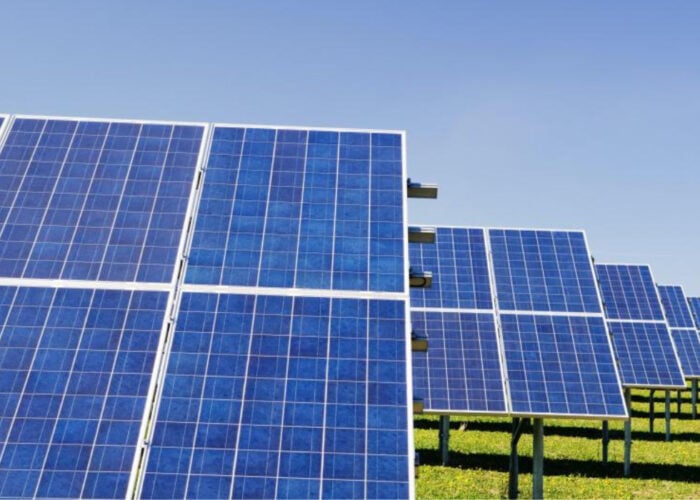The completion of South Africa’s latest utility PV power plant has coincided with new figures showing an “exponential” rise in the contribution solar is now making to the country’s grid.
As Spain’s Acciona Energía announced its 94.3MWp Shishen project had begun operation, the South African Photovoltaic Industry Association (SAPVIA) this week published data revealing how solar power production has mushroomed from less than 100MWh per hour to nearly 700MWh in a year.
Unlock unlimited access for 12 whole months of distinctive global analysis
Photovoltaics International is now included.
- Regular insight and analysis of the industry’s biggest developments
- In-depth interviews with the industry’s leading figures
- Unlimited digital access to the PV Tech Power journal catalogue
- Unlimited digital access to the Photovoltaics International journal catalogue
- Access to more than 1,000 technical papers
- Discounts on Solar Media’s portfolio of events, in-person and virtual
Acciona’s Shishen project is located in Dibeng in the Northern Cape Province and joins other recent high-profile completions under South Africa’s renewable energy independent power producer procurement programme (REIPPPP), including SolarReserve’s Jasper project.
In terms of nameplate capacity, Shishen narrowly misses out on the claim to being South Africa’s largest operational PV power plant by capacity, a distinction currently held by the 96MWp Jasper.
But Acciona claimed Shishen would be the country’s biggest project by output, offering 216GWh of electricity production annually.
Good times for solar
The completion of Shishen and the SAPVIA figures underline the extent to which PV power has become a key part of South Africa’s energy mix since the first REIPPPP projects began entering operation last year.
As can be seen in figures 1 & 2, to the left, by October 2014, the hourly generation of energy from solar PV plants had reached a peak as high as 673MWh.
SAPVIA’s chief executive, Moeketsi Thobela, said: “The period between end-2013 and October 2014 saw an exponential increase in electricity generation from solar PV.”
SAPVIA said solar’s contribution would rise further as projects under the second and third rounds of the programme become operational between now and 2016, with a total of 1,484MW in the pipeline.
Thobela said the rapid deployment of PV and other renewables “on time and on budget” under the REIPPPP made the case for the programme to be accelerated as a bulwark against blackouts and loadshedding in South Africa.
He said a “three-tier market model” should be adopted for PV in South Africa. “This model involves recognising that part of the uniqueness of the solar PV sector is its ability to provide energy solutions across different market configurations, for example utility-scale (REIPPPP projects), mid-scale (anything from 5MW to 50MW projects), as well as residential, commercial and industrial or rooftop applications,” Thobela said.
Right on cue, Bloomberg and other news outlets this week reported comments from South Africa’s minister in the presidency, Jeff Radebe, who is in charge of South Africa’s National Development Programme, saying the country would expand its grid-connected renewable energy capacity to 11.4GW over an unspecified timeline.
The pledge followed the publication of a five-part energy stabilisation plan by the South African government earlier this week in response to a period of rolling blackouts that have hit South Africa in recent weeks due to what was said to be a shortage of diesel supplies.
REIPPPP scrutiny
But alongside this, after its successful debut, the REIPPPP now appears to be facing challenges of its own. Last month SAPVIA said projects under round three of the programme were struggling to reach financial close amid reports that the national utility, Eskom, is facing grid constraint issues.
SAPVIA subsequently said this situation had eased and that round-three projects were close to reaching financial close. But then shortly after, it emerged that the government had delayed an announcement of the preferred bidders in the fourth round of the REIPPP programme expected on 24 November with the same problem said to be behind the delay.
Speaking to PV Tech, Thobela said that although he understood the delayed round-four announcement would be made before Christmas, issues such as grid constraints and pricing needed to be given greater consideration in future rounds of the programme.
“In this respect, an option is to assign more value to projects that are located in areas that do not have grid constraints, or where economically viable, the incorporation of self-build requirements as early as possible in the bidding process,” Thobela said. “An independent, state-owned transmission organisation is required to provide the institutional framework that is required to sustainably and transparently address issues related to grid access for IPPs.”
Thobela said a further issue under discussion was the extent to which prices will continue to fall, and whether some consideration should be given to moving towards fixed prices – “without losing the price-discovery attributes of the REIPPPP”.
“This could be in the form of using REIPPPP prices as benchmarks for fixed prices in other market configurations – such as the mid-scale [5-50MW] as well as residential, commercial and industrial (RCI) solar PV markets. It is important to emphasise that this is a debate that is currently underway.
“The fourth round bid prices will therefore be closely watched in this regard, while the urgency of taking bolder action in unlocking the RCI markets has become more evident in light of the five-point electricity stabilisation plan, announced by the South African Cabinet on 11 December 2014. For instance, solar PV stands to play a significant role in helping Eskom and municipalities implement the demand-side management initiatives envisaged as part of the five-point plan,” Thobela concluded.







